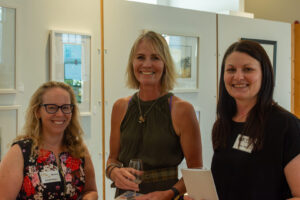Who We Are
The WSA was founded in 1934 and we are a not for profit charitable trust. We provide opportunities for local artists to exhibit their work, engage in artistic development, and connect with other creatives. The WSA stands for inclusivity and supports
artists of all ages and backgrounds. We have built strong relationships with
schools, artists and community groups, actively promoting mental
wellbeing through creative process and expression and we are committed to
co-creating safe spaces for story telling and healing through arts.
The WSA holds monthly exhibitions all year in five art galleries, runs workshops, three national art awards, operates a beautiful retail space featuring New Zealand artists and hosts events to foster a vibrant arts community.
We run an Art School for over 800 students, ranging from 5 years old to students in their nineties, all varying abilities. We run tutored, untutored and drop-in casual classes, including school holiday programmes. The WSA works to enhance the appreciation of visual arts within the region and contribute to the cultural life of Waikato.
Our Mission Statement
The mission of the Waikato Society of Arts is to support and promote the visual arts in the Waikato region by providing opportunities for artists to exhibit their work, fostering artistic development, and enhancing the appreciation of art in the community while respecting Te Tiriti o Waitangi.

Our Executive Committee
Our Executive committee meets monthly and is the governing body of the WSA.
Our committee is a group of volunteers with specific skills to help govern the Waikato Society of Arts.
Rachael Hayton
Treasurer, Past Chair
Melany Sutherland
Co-Chair
Esther Price
Human Resources
Christine Melchior
Project Development
Craig Stephen
Co-Chair, Strategic Planning
Graham Haines
Auditor
Charlotte Isaac
Honorary Solicitor
Julie Johnstone
Honorary Secretary
Nancy Caiger
Patron
Our Life Members
These members, past and current, have contributed many years of service to the WSA voluntarily and/or as tutors.
Their input to the society has laid solid foundations and continued to help make us grow into an organisation
that has proven the test of time in the visual arts community for over 90 years:
Martha Simms
Jane Finch
Robert Gardiner
Enid Claris
Graeme and Elaine Henry
Pat Paterson
Robin Cuff
Frances Van Dammen
Betty Fistonich
Brenda Sayers
Anne Kalnins
Delys Lodge
Janice Meadows
Sue Burnett
Nelsy Jordan
Grant MacKintosh
Steph McLellan
Anne Carter-Jones
Carril Karr
In Memoriam
We pay tribute to those who have since passed away and the legacy they
have left behind through their charitable work for the Waikato Society of Arts.
Mr Campbell Smith
Mrs A Bell
Mr W. W. Dillicar
Miss Ida Carey
Mrs Adele Younghusband
Mr C. Haswell Paine
Mrs Florence Powell
Dr and Mrs E.T. Rogers
Mr G.E. Fairburn
Mr A.F. de Lisle
Mr R Starr
Mr Mike Stringfield
Ms Mary de Lisle
Ms Joan Travaglia
Mrs Heather Lomas
Mr Stanley Boyle
Mr Philip Vela
Gudde Moller
Barry Hopkins
Dennis Hole
Warren Scotter
Christine Schroder
Glennis du Chatenier
Anne Sayers
Joan Fear
Gillian Bigham
Ian Witten
Gay Fraundorfer
Jan Kaywood
Roger Buckell
Ruth Davey
Special Mention
Ruth Davey
15 December 1923 – 26 December 2023
When Ruth and Lester Davey moved to Hamilton in 1960, one of the first things they did was join the WSA. This proved the beginning of a long and fruitful relationship with the organisation and the foundation of many art friendships and collaborations.
After first studying monoprint with Campbell Smith, she commuted to Auckland to learn more techniques and later began to build her printmaking skills with local mentors, such as Susan (Poff) Flight in Thames. By 1973 Ruth had established printmaking classes at the WSA Art School. Through the art school she taught relief and intaglio printmaking, drawing, watercolour and papermaking.
1970 saw her first exhibition, with Campbell Smith and Irma Conroy. In 1975 she was in the International Year for Women exhibition, Eight Waikato Artists, and had her first solo exhibition in 1978 at Studio Gallery. Her WSA friends will remember her part in the annual printmaking exhibition that became Waiprint and in the popular Left Bank festivals.
Over the following years Ruth exhibited around NZ and overseas, including in the UK, where she spent two extended study periods in Cumbria and Bristol. She was a foundation member of Print Council Aotearoa NZ (established in 2000 as Central Print Council) and has been an enthusiastic participant in their workshops and exhibitions, forming many new print friendships.
Ruth continued teaching etching classes until the mid-1990s, gradually handing over to Joan Travaglia and Stan Boyle, and afterwards came along as a classmate, always happy to help out with advice or a demo.
In 2013 she was in the group exhibition at Waikato Museum: Don’t Fence Me In: Wise Waikato Women Artists 1930s-1970s. Later that year, in time for her 90th birthday, came a retrospective exhibition at ArtsPost: Ruth Davey: A Lifetime of Drawing and Printmaking.
In recognition of her importance as a Waikato artist, the Waikato Museum has acquired many of Ruth’s prints and virtually all of her sketchbooks, dating back to the 1950s.
Following their move to Hilda Ross Retirement Village, the Daveys put the remainder of Ruth’s art in the stewardship of the WSA. Today, these prints – some framed and many more unframed – are available to purchase from the WSA’s artspost shop.
All proceeds from the sale of Ruth’s art go to the Ruth Davey Merit in Printmaking prize, established in 2020, and awarded at the annual New Zealand Painting and Printmaking Awards.
